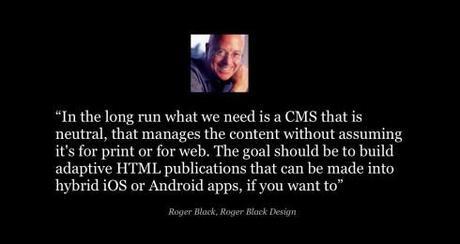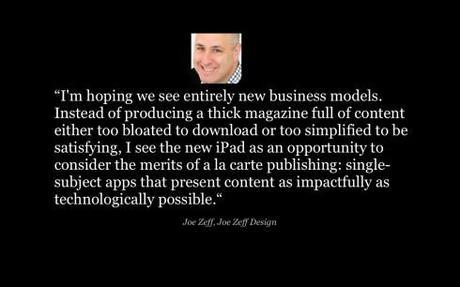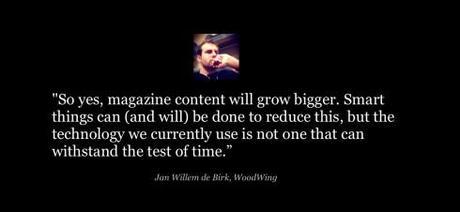TAKEAWAY: The next generation iPad’s Retina Display doubles resolution and pixel, but it also raises concerns, especially among magazine publishers who fear their editions may result in files too heavy for easy consumption. Experts offer their opinions on the subject here today.

Size does matter when it comes to file size for mag apps
The announced arrival of the new iPad 3 has generated a lot of excitement, plenty of orders (with deliveries now postponed beyond March 17 for those pre ordering online), and, among some members of the publishing industry, concern.
As those who have seen the many iPad 3 demos know, the next generation iPad’s Retina Display doubles resolution and pixel. In fact, Apple refers to it as “resolutionary”. Featuring an A5X system-on-chip with quad-core graphics, the Retina display offers 44% greater color saturation than its predecessor.
The new iPad has a pixel density of 264 ppi, twice that of the iPad 2. Its resolution now stands at 2048 by 1536 pixels, which is even larger than a 1080p flatscreen TV.
This means that those mag app files, which in some cases tend to be quite heavy, may become more so.
At the core of the problem is the methods used by most magazine publishers to transfer the voluminous pages and content of their print editions to a tablet app. David Sleight, a publishing and design consultant, put it best:
“The iOS apps created by systems from Adobe, Woodwing, Mag+, and others—the platforms used by the bulk of traditional publishers to crank out their iPad magazines right now—are essentially collections of PDFs or JPGs exported out of programs like InDesign and bound inside a wrapper application. Basically, they boil down to pictures of layouts, photos, and text. Rather than create new rendering engines from scratch, these platforms rely on existing desktop applications to do that work, then package up the output. While faster to develop, this has negative consequences for the end user. You can’t resize text. File sizes are untenably large.“
He states that “the size of a magazine app is about to go through the roof”.
Will this in, anyway, cool the enthusiasm that magazine publishers feel towards the tablet and the iPad specifically?
In an effort to get some opinions on this important subject, I have contacted my colleagues in the industry with first hand knowledge of the issue.
From Roger Black, of Roger Black Design

“Adobe tools are built around the current workflow for print publications, and Woodwing adds a CMS that manages print production (very nicely). What they’re doing is to move the publications to the iPad and other devices.
“These targets have been multiplying, and now Apple is effectively adding a new screen size, which results in much bigger files. The real problem is that the targets will continue to multiply. Even if hand-building digital publications was a good idea, it is going to get harder and harder to keep up.
“What we need is adaptive layout. Adobe is expected to add this functionality to InDesign in the next release, but it is not clear if their Digital Publishing Suite will use real fonts in the iPad app—or will they still just be bundling pictures of the layout.
“In the long run what we need is a CMS that is neutral, that manages the content without assuming it’s for print or for web. The goal should be to build adaptive HTML publications that can be made into hybrid iOS or Android apps, if you want to.“
For more on Roger’s ideas on the subject: http://rogerblack.com.
Joe Zeff, Joe Zeff Design

“After a decade of web design characterized by staleness, stiffness and sameness, the digital newsstand has sprung to life over the past two years thanks to platform-based solutions that turned print designers into tablet programmers. Expect HTML, Adobe’s Liquid Layout and responsive design to make that content more flexible in the months and years to come. Until then, publishers face quandaries: Do they continue to produce 768 x 1024 magazines that work flawlessly on the 55 million iPads already on the market and, hopefully, well enough on the new iPads? Do they make higher-definition apps best-suited for newest batch of iPads, which have the processors and screens to showcase these products but lack the storage and bandwidth to accommodate them? Or do they blend HTML with platforms like Adobe, either in part or in total, while giving back some of the pinpoint control over design that has helped to define these brands on the tablet?
“I’m hoping we see entirely new business models. Instead of producing a thick magazine full of content either too bloated to download or too simplified to be satisfying, I see the new iPad as an opportunity to consider the merits of a la carte publishing: single-subject apps that present content as impactfully as technologically possible. Change is inevitable; and those best-suited to seize the opportunities presented by innovative products like iPad 3 will forge longstanding relationships with their owners. But many of today’s magazines are too unwieldy to meet that challenge. In the end, the most agile publishers will come out ahead, leveraging a combination of platform approaches and custom development.“
Visit Joe Zeff Design here: http://joezeffdesign.com/
Jan Willem de Birk, WoodWing

“First of all I think David Sleight is, in essence, correct about most of his statements.
The solutions as they exist today are indeed based on existing functionality. When the iPad first came out it was basically a reenactment of the race to the moon. Nobody really cared about how to get there as long as they got there first.
“And we did. We built a solution that was easy for the publisher to use and relatively intuitive for the end-user. At the time, there was nothing like the iPad and there was little experience with such interfaces. That experience was even more lacking at the side of the people capable of building the software to create and read digital magazines, like WoodWing.
“Of course research had been done and prototypes had been developed by multiple in-depended companies (from design companies to software companies, I can’t find any examples at the moment) but none of them had really taken off because they didn’t have the tools to create the content. WoodWing (and in a sense, Adobe) managed to leverage their existing workflow and made it so that the content creation was a breeze (compared to other solutions). There was hardly any learning curve for the publisher and at the start of the iPad-hype, and with that the Digital Magazine gold rush, it was very important to get publishers to adopt a solution as soon as possible to get with the momentum. The solution that we created, however, was not a durable one.
“Several software companies saw that on forehand. One of them was Apple with the creation of iBooks who first used the ePub format and when that didn’t suffice they came with their own set of creation tools to build more scalable digital magazines, but they lack the workflow support. Another company that had identified this problem early on was Adobe. When they introduced Liquid Layout they introduced a way of creating ‘resolution independent’ content, integrated into their existing workflow, and with that WoodWing’s workflow as well. I’m sure (very sure) Adobe is working hard to get Liquid Layout onto tablets as soon as possible but creating an engine from scratch, on several different devices and make it scalable for the future, is no easy task. It takes time and the standards, in the form of the current generation of digital magazines, have already been set high.
“Then there is the problem with design heavy publications. Newspapers for example are obviously a little easier to scale than a magazine. Design heavy publications will always, with current technologies, rely on some form of images. They will not all be able to create vector based images and will have to include multiple versions of those images or choose to go with lower quality content. Even with a rendering engine these issues exist.
“Apple has the same issues with their application assets; everything is included twice and for a universal binary even four times. This does increase the quality of the user experience at the cost of making applications a lot bigger. At some point that is inevitable and even Apple sees it, but tries to minimize it.
For magazines, where each page or interactive object currently is an asset, the problem seems even bigger. However, instead of packaging the magazine multiple times for different resolutions we have a very smart server behind our solution that has a notion of renditions. It is able to serve up content in the right format for a specific device. Of course, at this point that is all pre-rendered but perhaps in the future it could be the server that is the rendering engine, instead of the device itself.
“So yes, magazine content will grow bigger. Smart things can (and will) be done to reduce this, but the technology we currently use is not one that can withstand the test of time.
However ,we live in very exciting times where new technology is raining down upon us and grows more advanced by the minute. It is up to the developers to embrace the power of that technology and create intelligent solutions for the problems that we are now facing, or about to face. One of them being content size, another being user experience. It is up to the publishers to support these developers in new idea’s, learning new tools and maybe giving up some of what they are used to today.
“We, developers, publishers and end-users, are still learning the new tools given to us. I know that there are a lot of people right now working hard on new technology that will change the way we create, consume and experience digital magazines. Until that time I think we’ll have to make due with a little less free disk space.“
Visit WoodWing: http://woodwing.com/
Claus Enevoldsen, NextIssue

“The introduction of these super HD screens such as the new iPad makes it so much more appealing for publishers to create visually driven stories. But obviously higher resolution images comes at a price – image file sizes will increase dramatically and as a result, tablet magazine editions, in their current state, will get really big. The bigger the file, the more painful it is for the end user to download.
“Here are two ways we can address the issue:
The only reason we talk about file sizes, is because it’s painful for the end user. The download time is horrendous and it takes up your tablet memory. But if we can get rid of these pain points, who cares how big the files are. Magazine apps need to become better at managing background downloading and they need to become better at managing storage space and automatically deleting old issues based on user settings. At SXSW, I spoke with Chris Wilkes, VP of the App Lab at Hearst, and he made a great analogy. No one considers the file size, when they are streaming a Netflix movie on their tablet. Magazines need to get to that place.
“Further down the line, I think responsive design offers some opportunities as well. At SXSW, I spoke at length with Miranda Mulligan, Design Director at The Boston Globe, and she said it’s been challenging to get the image sizing right on the new responsive design basedbostonglobe.com. But, as we move forward, Responsive Images (filament group) or Adaptive Images (Matt Wilcox) could be the answer to dealing with HD screens.“
Visit NextIssue: http://www.nextissue.com/
Erik Schut, WoodWing
“The statement is true for JPG based solution, however with Adobe/WoodWing it can also use PDF for which the statement is incorrect, text is not rasterized but vectors. The filariae does get up though if you want to take advantage of the retina for photo’s, the more photo oriented the larger the increase.“
Visit WoodWing: http://woodwing.com/
Of related interest:
3.1 million pixels are heavy
http://globalmoxie.com/blog/new-ipad-image-sizes.shtml
First paragraph:
“AS EVERYONE IN THE WORLD KNOWS BY NOW, Apple bumped the iPad’s screen to retina-display density, quadrupling the number of pixels to a whopping 3.1 million. That’s fantastic news for iPad owners—the display will be gorgeous—but it also means more headaches for designers and a potential blight on your bandwidth bill and download speed.“
Of Interest today
- USA: 10 Newspapers That Do It Right 2012
http://www.editorandpublisher.com/TopStories/Article/10-Newspapers-That-Do-It-Right-2012
- USA: For tablet computer visionary Roger Fidler, a lot of what-ifs
http://www.washingtonpost.com/business/for-tablet-computer-visionary-roger-fidler-a-lot-of-what-ifs/2012/02/28/gIQAM0kN1R_story.html
- New iPad: Is Your Content Ready for the HD Tablet Revolution?
http://mashable.com/2012/03/08/web-design-new-ipad/

